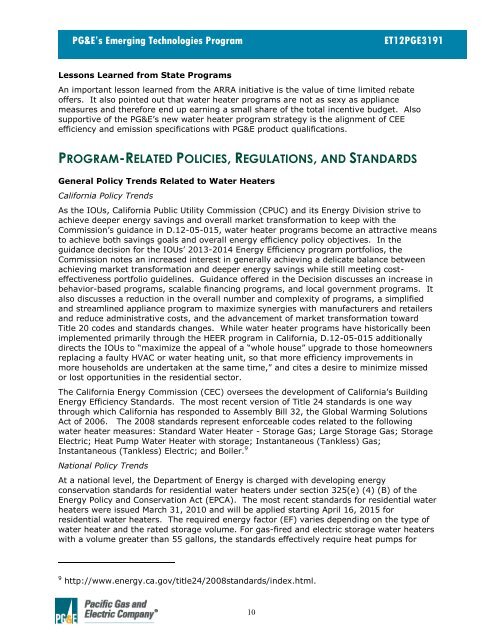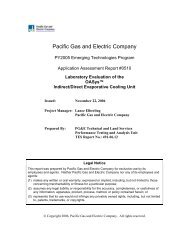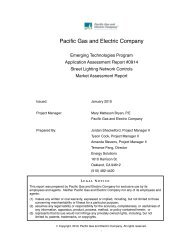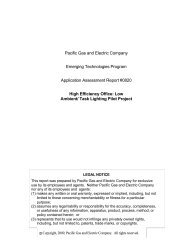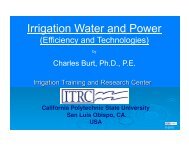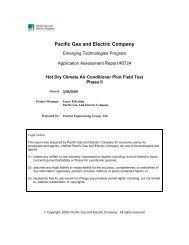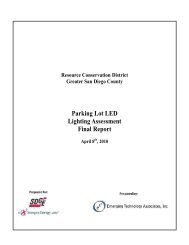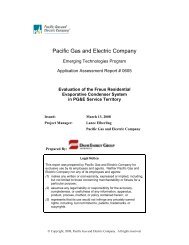PGE Water Heater ET Final Report - FINAL.pdf - Emerging ...
PGE Water Heater ET Final Report - FINAL.pdf - Emerging ...
PGE Water Heater ET Final Report - FINAL.pdf - Emerging ...
Create successful ePaper yourself
Turn your PDF publications into a flip-book with our unique Google optimized e-Paper software.
PG&E’s <strong>Emerging</strong> Technologies Program <strong>ET</strong>12<strong>PGE</strong>3191<br />
Lessons Learned from State Programs<br />
An important lesson learned from the ARRA initiative is the value of time limited rebate<br />
offers. It also pointed out that water heater programs are not as sexy as appliance<br />
measures and therefore end up earning a small share of the total incentive budget. Also<br />
supportive of the PG&E’s new water heater program strategy is the alignment of CEE<br />
efficiency and emission specifications with PG&E product qualifications.<br />
PROGRAM-RELATED POLICIES, REGULATIONS, AND STANDARDS<br />
General Policy Trends Related to <strong>Water</strong> <strong>Heater</strong>s<br />
California Policy Trends<br />
As the IOUs, California Public Utility Commission (CPUC) and its Energy Division strive to<br />
achieve deeper energy savings and overall market transformation to keep with the<br />
Commission’s guidance in D.12-05-015, water heater programs become an attractive means<br />
to achieve both savings goals and overall energy efficiency policy objectives. In the<br />
guidance decision for the IOUs’ 2013-2014 Energy Efficiency program portfolios, the<br />
Commission notes an increased interest in generally achieving a delicate balance between<br />
achieving market transformation and deeper energy savings while still meeting costeffectiveness<br />
portfolio guidelines. Guidance offered in the Decision discusses an increase in<br />
behavior-based programs, scalable financing programs, and local government programs. It<br />
also discusses a reduction in the overall number and complexity of programs, a simplified<br />
and streamlined appliance program to maximize synergies with manufacturers and retailers<br />
and reduce administrative costs, and the advancement of market transformation toward<br />
Title 20 codes and standards changes. While water heater programs have historically been<br />
implemented primarily through the HEER program in California, D.12-05-015 additionally<br />
directs the IOUs to “maximize the appeal of a “whole house” upgrade to those homeowners<br />
replacing a faulty HVAC or water heating unit, so that more efficiency improvements in<br />
more households are undertaken at the same time,” and cites a desire to minimize missed<br />
or lost opportunities in the residential sector.<br />
The California Energy Commission (CEC) oversees the development of California’s Building<br />
Energy Efficiency Standards. The most recent version of Title 24 standards is one way<br />
through which California has responded to Assembly Bill 32, the Global Warming Solutions<br />
Act of 2006. The 2008 standards represent enforceable codes related to the following<br />
water heater measures: Standard <strong>Water</strong> <strong>Heater</strong> - Storage Gas; Large Storage Gas; Storage<br />
Electric; Heat Pump <strong>Water</strong> <strong>Heater</strong> with storage; Instantaneous (Tankless) Gas;<br />
Instantaneous (Tankless) Electric; and Boiler. 9<br />
National Policy Trends<br />
At a national level, the Department of Energy is charged with developing energy<br />
conservation standards for residential water heaters under section 325(e) (4) (B) of the<br />
Energy Policy and Conservation Act (EPCA). The most recent standards for residential water<br />
heaters were issued March 31, 2010 and will be applied starting April 16, 2015 for<br />
residential water heaters. The required energy factor (EF) varies depending on the type of<br />
water heater and the rated storage volume. For gas-fired and electric storage water heaters<br />
with a volume greater than 55 gallons, the standards effectively require heat pumps for<br />
9 http://www.energy.ca.gov/title24/2008standards/index.html.<br />
10


